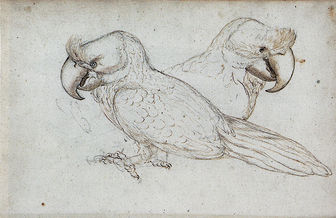Lophopsittacus mauritianus
It was a large, heavy-set parrot, with strong males similar in size to the Palm Cockatoo. Females were considerably smaller. The species is known from early drawings and subfossil bones. It had a long tail and a reduced flight apparatus and was probably flightless. The bill was very large but comparatively weak and probably adapted to crush the pulp of large fruits so that they could be swallowed, pit and all. The color was all bluish gray, and there was a small frontal crest. The discovery of the structure of the bill has led to the hypothesis that this bird, not the dodo, was one of the main animals responsible for propagation of the Tambalacoque or dodo tree.

The Lophopsittacus mauritianus is classified as Extinct (EX), there is no reasonable doubt that the last individual has died.
Summary Lophopsittacus mauritianus is known from numerous bones and travellers' reports and sketches from Mauritius2. Hoffman, writing in 1680 based on observations in 1673-1675, gave the last definite reports of the species1. Ecology: There is very little known, although it is likely to have been a forest species and its heavy bill indicates it specialised on large nuts. More
Family : Psittacidae
Genus : Lophopsittacus
Species : mauritianus
Authority : (Owen, 1866)

